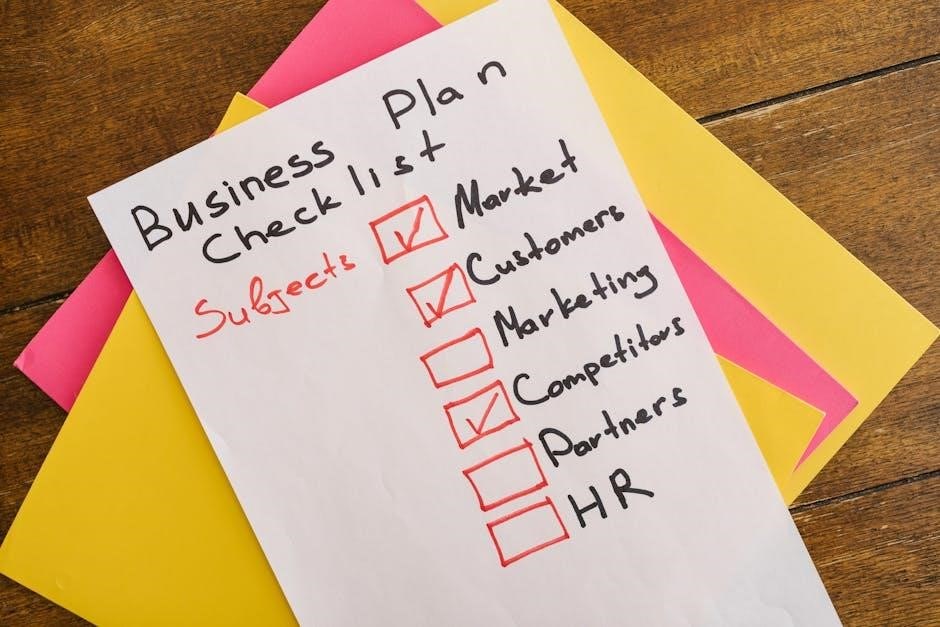A prepper’s checklist is a comprehensive guide to help individuals prepare for emergencies. It includes essential supplies, tools, and strategies to ensure safety and sustainability.
What is a Prepper’s Checklist?
A prepper’s checklist is a detailed, customizable guide designed to help individuals and families prepare for emergencies and disasters. It typically includes essential supplies, tools, and strategies to ensure safety and sustainability during crises. The checklist covers categories like food, water, first aid, shelter, and security, providing a structured approach to preparedness. Many checklists are available as free PDF downloads, offering portability and easy sharing. They often feature tips, stories, and space for personalization, making prepping manageable and less overwhelming. By organizing resources and priorities, a prepper’s checklist simplifies the preparation process, ensuring readiness for various scenarios. It serves as a practical roadmap for building resilience.
Why is a Prepper’s Checklist Important?
A prepper’s checklist is crucial for ensuring readiness in emergencies. It provides a structured approach to preparedness, covering essential supplies like food, water, and first aid. By organizing priorities, it reduces uncertainty and stress. The checklist helps users stay proactive, tracking progress and identifying gaps. Customizable options allow personalization, making it adaptable to various scenarios. It serves as a clear roadmap, breaking down complex tasks into manageable steps. With a checklist, individuals can avoid oversight and ensure they are equipped for crises. This tool fosters confidence and peace of mind, knowing they are prepared for the unexpected. It is an indispensable resource for building resilience.

Essential Supplies for Prepping
Essential supplies include non-perishable food, water, first aid kits, and shelter gear. Organizing these items ensures readiness and simplifies preparation for emergencies.
Food and Water Storage
Proper food and water storage is crucial for long-term survival. Stockpile non-perishable items like dried fruits, canned goods, and MREs. Store at least one gallon of water per person daily. Rotate supplies every six months to ensure freshness. Consider a water filtration system, such as the Big Berkey, for purification. Use airtight containers to protect food from moisture and pests. Label and date all items for easy tracking. A well-organized storage system ensures resources remain accessible and usable during emergencies. Regularly check expiration dates and replenish as needed to maintain a reliable supply. This step is foundational to any prepping plan.
First Aid and Medical Supplies
A well-stocked first aid kit is essential for treating injuries and preventing infections. Include bandages, antiseptics, pain relievers, and medical gloves. Don’t forget prescription medications and essential tools like tweezers and scissors. Consider adding a first aid manual for guidance. Regularly check expiration dates and restock as needed. Advanced preppers may include items like sutures and splints for more severe injuries. Keep supplies in an easily accessible location and ensure all household members know where it is. A comprehensive first aid kit can make a significant difference in emergency situations, helping to stabilize conditions until professional help is available. Stay prepared with quality medical supplies.
Shelter and Sleeping Gear
A reliable shelter and sleeping setup is crucial for survival. Invest in a sturdy tent with waterproof material and a durable frame. Include a sleeping bag rated for extreme temperatures and a ground tarp for added protection. Rope, stakes, and a camping stove with fuel are essential for setting up camp. Don’t forget matches or a lighter for fire starting. A flashlight with extra batteries ensures light sources. Warm blankets and emergency bivvy sacks can provide additional warmth. Regularly inspect and maintain your gear to ensure reliability. Consider lightweight options for portability, especially in bug-out scenarios. Practice setting up your shelter to build proficiency and speed.

Survival Tools and Gear
Essential tools include fixed blade knives, multi-tools, and firearms with ammunition. Prioritize quality over cost for reliability in critical situations. These tools ensure versatility and effectiveness in emergencies.
Fixed Blade Knives and Multi-Tools
A fixed blade knife, like the Morakniv Companion or Buck 119, is a durable and versatile tool for cutting, carving, and self-defense. Multi-tools, such as Leatherman models, offer multiple functions like pliers, screwdrivers, and scissors, making them indispensable for repairs and tasks. These tools are essential for survival, as they provide reliability in critical situations. Investing in quality ensures they perform when needed most. Keep them accessible in your bug-out bag or shelter for emergencies. Regular maintenance, like sharpening and cleaning, extends their lifespan. These tools empower preppers to handle a variety of challenges, from food preparation to constructing shelter.
Firearms and Ammunition
Firearms and ammunition are critical for security and self-defense in emergency scenarios. A reliable handgun or rifle, along with a sufficient ammo supply, is essential for protecting your family and resources. Prioritize quality over quantity, as durable firearms perform better under stress. Store ammunition in a cool, dry place to maintain viability. Regular maintenance, such as cleaning and lubricating, ensures functionality. Consider additional supplies like holsters and magazines for accessibility. Always adhere to safety protocols and legal guidelines when handling firearms. Proper training and practice are vital to ensure effective use in high-stress situations. A well-prepared arsenal enhances your ability to safeguard your shelter and loved ones.
Alternative Energy Sources
Alternative energy sources are vital for sustaining power during emergencies when traditional utilities fail. Solar panels, wind turbines, and portable generators provide reliable energy solutions. Consider investing in a BioLite stove, which uses biomass like wood for cooking and charging devices. Portable solar chargers are ideal for recharging batteries and small electronics. Store extra fuel for generators, ensuring it remains usable with proper storage. Alternative energy sources enhance self-sufficiency, allowing you to power essential appliances and communication devices. Regular maintenance and testing of these systems ensure they function when needed most. Diversifying energy options increases resilience and preparedness for long-term scenarios.

Security and Defense
Security and defense are critical for protecting yourself, family, and resources during crises. Plan for self-defense tools, firearms, and early warning systems to ensure safety and deter threats.
Self-Defense Tools and Strategies
Self-defense tools and strategies are vital for protecting yourself and loved ones in emergency situations. Consider investing in a fixed blade knife, such as the Morakniv Companion or Buck 119, for reliability and durability. Multi-tools can also serve multiple purposes in survival scenarios. Firearms and ammunition should be part of your security plan, ensuring proper training and storage. Additionally, develop strategies for situational awareness, de-escalation techniques, and physical defense. These tools and strategies provide a layered approach to security, enhancing your ability to respond effectively to potential threats. Always prioritize quality and practicality when selecting self-defense equipment.
Early Warning Systems and Surveillance
Early warning systems and surveillance are critical for detecting potential threats before they escalate. Motion-activated cameras, alarms, and tripwires can alert you to intruders or wildlife. Drones and binoculars enhance surveillance capabilities, while night vision devices improve visibility in low-light conditions. Consider solar-powered systems for reliability during power outages. Additionally, monitoring tools like two-way radios and perimeter fencing can strengthen security. Regularly test and maintain these systems to ensure functionality. Incorporating guard animals, such as dogs, can also provide an additional layer of alertness. A well-integrated surveillance system allows for timely responses, enhancing overall safety and preparedness for any scenario.

Preparedness Strategies
Creating a customizable checklist ensures tailored preparedness, while budgeting tips make prepping affordable. Organize supplies, prioritize needs, and regularly update your plan to stay proactive and resilient.
Creating a Customizable Checklist
A customizable checklist is a versatile tool for preppers, allowing personalization to fit specific needs and scenarios. It ensures that no essential item or task is overlooked. By incorporating space for additional entries, users can adapt the list to their unique circumstances. The checklist can be formatted as a workbook, complete with tips and stories to guide newcomers. Tracking supplies, like food and water, becomes manageable, and regular updates ensure preparedness. This approach makes prepping less overwhelming, enabling individuals to stay organized and focused. Whether printed or digital, a well-crafted checklist is a cornerstone of effective preparedness strategies.
Budgeting Tips for Prepping
Budgeting for prepping is crucial to avoid financial strain while building a preparedness plan. Start by prioritizing essential items like food, water, and first aid supplies. Allocate a portion of your budget to quality tools and gear, as durability is key in emergencies. Consider purchasing in bulk or during sales to save costs. Setting aside a small, consistent amount each month ensures steady progress without overwhelming expenses. Utilize free resources, such as printable PDF checklists, to stay organized. By balancing needs with budget, prepping becomes achievable and sustainable, ensuring readiness without compromising financial stability. Smart budgeting makes preparedness accessible to everyone.
Advanced Prepping Topics
Advanced prepping involves specialized strategies like water purification, EMP protection, and long-term sustainability. These methods ensure preparedness for severe scenarios, offering in-depth solutions for experienced preppers.
Water Purification Methods
Water purification is crucial for survival, and preppers often rely on methods like bleach treatment or systems such as the Big Berkey. These tools ensure safe drinking water, even in emergencies.
Ceramic filters and solar disinfection are also effective, offering portable solutions for purifying water. Regular maintenance and storage of purification supplies are essential to guarantee reliability when needed most.
Having a backup plan, such as water storage and filtration kits, ensures access to clean water during crises. These methods are detailed in prepper checklists to help individuals stay prepared and self-sufficient.
Communication Devices and Signal Tools
Reliable communication is vital during emergencies, making devices like two-way radios and satellite phones essential. These tools ensure connectivity when traditional networks fail, helping preppers stay informed and coordinate with others.
Signal tools, such as flares and whistles, are also crucial for signaling help or marking locations. Including these in a prepper’s checklist ensures that communication needs are met, enhancing safety and coordination during crises.
Regular maintenance and testing of these devices are recommended to guarantee functionality when needed most. Detailed guides in prepper resources provide tips for selecting and using these tools effectively.
Emergency Scenarios and Planning
Understanding potential scenarios like natural disasters or economic collapse is key to effective prepping. A well-planned strategy ensures readiness for various emergencies, helping you stay safe and resilient.
Bug-Out Bag Essentials
A well-prepared bug-out bag is crucial for emergencies, ensuring you can quickly evacuate with necessities. It should include at least 72 hours of supplies, such as water (1 gallon per person per day), non-perishable food, a first aid kit, and a multi-tool or knife. Shelter items like a lightweight tent, sleeping bag, and tarp are vital. Communication tools, such as a portable radio and whistle, help stay connected. Don’t forget extra clothing, sturdy footwear, and personal hygiene items. Maps of your area and important documents (e.g., IDs, insurance) should also be included. Regularly check expiration dates and customize the bag to fit your family’s needs.
Long-Term Shelter and Sustainability Plans
Long-term shelter and sustainability plans are critical for extended survival scenarios. Identify a safe location with access to water, food, and energy sources. Consider building or retrofitting a shelter with durable materials, such as wood or steel, to withstand harsh conditions. Incorporate renewable energy solutions like solar panels or wind turbines to ensure power availability. Plan for waste management and sanitation systems to maintain health. Stockpile seeds, tools, and fertilizers for gardening and food production. Develop a water collection and purification system to sustain life. Finally, establish a community plan to share resources and responsibilities, ensuring a sustainable and secure future for all members.